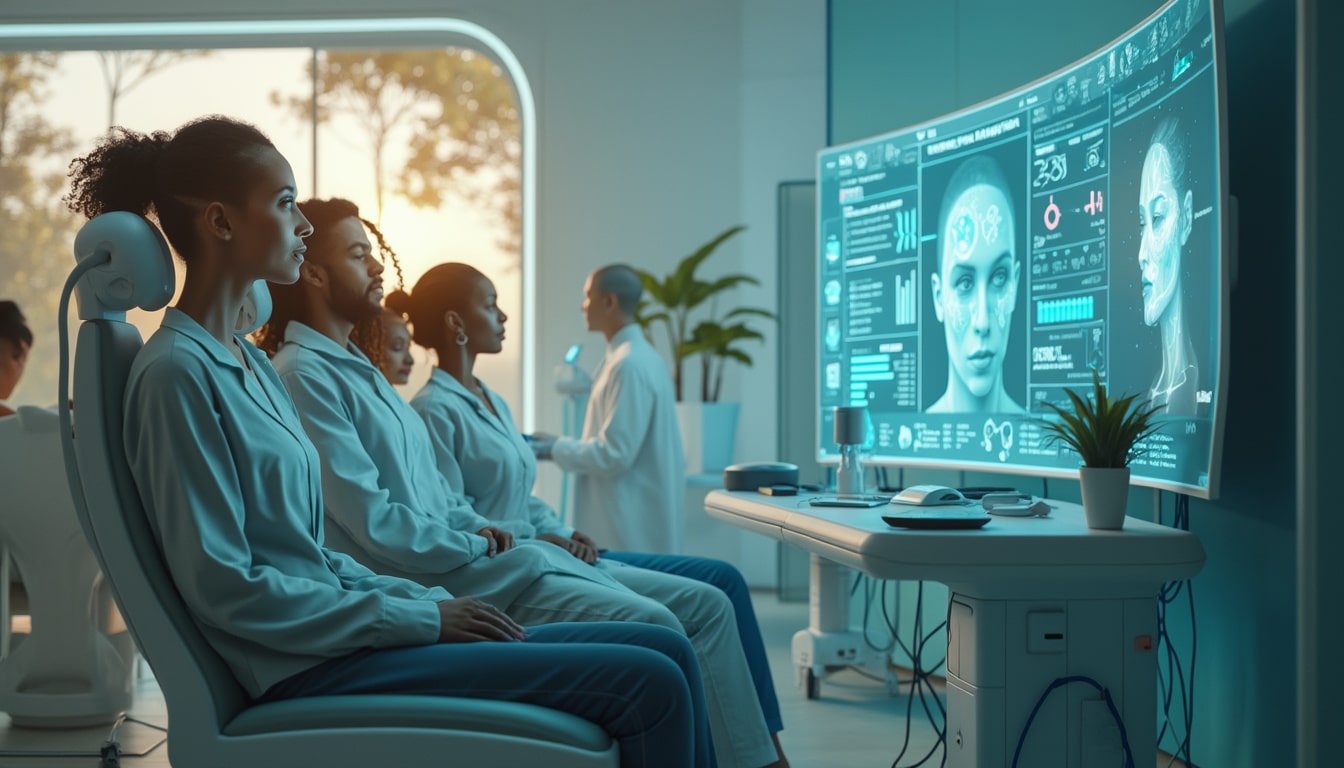What if the mere thought of an action could execute it on your phone? Apple is making this a reality, aiming to empower individuals with severe motor impairments. By partnering with the Australian startup Synchron, Apple is venturing into the realm of brain-computer interfaces.
This groundbreaking collaboration focuses on implants placed near the motor cortex, capturing electrical signals associated with movement intentions. These signals are then translated into digital commands for devices like the iPhone, iPad, or Vision Pro. For those battling conditions such as amyotrophic lateral sclerosis (ALS), everyday interactions become monumental challenges. Apple’s Switch Control technology, now enhanced with cerebral signal compatibility, offers a hands-free solution, enabling actions like selecting applications through thought alone. While the system’s speed doesn’t yet match a simple tap on the screen, its true value lies in providing access. This innovative approach reestablishes a crucial link between users and their digital environments, heralding a new era of accessibility driven by pure intent.

Table of contents
Togglehow apple is bridging minds and devices with brain-computer interfaces
Imagine controlling your iPhone or Vision Pro simply by thinking about it. Apple is making this a reality by developing a brain-computer interface (BCI) that connects your mind directly to your devices. This groundbreaking technology aims to provide unprecedented accessibility for individuals with severe motor impairments, revolutionizing how we interact with technology.
what is apple’s brain-computer interface and how does it work?
Apple’s brain-computer interface is an innovative system that translates electrical signals from the brain into digital commands. In collaboration with the Australian startup Synchron, Apple has developed implants placed near the motor cortex, the area of the brain responsible for movement. These implants detect the electrical impulses associated with the intention to move, converting them into actionable commands for devices like the iPhone, iPad, and Vision Pro.
This technology leverages advanced neural interfaces to interpret user intentions without the need for physical input. By capturing these signals, the BCI allows users to perform tasks such as selecting applications, navigating interfaces, and even controlling augmented reality experiences using only their thoughts. While the system is still in its early stages and not as fast as traditional touch interfaces, its primary focus is on providing access rather than speed, offering a lifeline for those who previously couldn’t interact with their devices.
For more insights into how AI is advancing energy efficiency by mimicking the human brain, check out this article.
how does apple’s bci enhance accessibility for individuals with motor impairments?
Individuals suffering from conditions like scleroderma lateral amyotrophic (SLA) often find simple interactions with their environment challenging. Apple’s Switch Control technology has been a game-changer in accessibility, and with the integration of BCI, its capabilities are expanding even further. The BCI allows users to control their devices through thought alone, bypassing the need for physical gestures which can be difficult or impossible for those with severe motor impairments.
With the BCI, selecting an application or navigating through menus on an iPhone becomes a thought-driven process. This hands-free control not only fosters greater independence but also significantly improves the quality of life for users by restoring their ability to interact with technology seamlessly. The collaboration with Synchron has been pivotal in advancing this technology, ensuring that the interface is both reliable and user-friendly.
Furthermore, this technology is a testament to Apple’s commitment to inclusivity, ensuring that digital tools are accessible to everyone, regardless of physical limitations.
what role does synchronization play in apple’s bci development?
Synchronization with the Australian startup Synchron has been central to Apple’s advancement in brain-computer interface technology. Synchron specializes in developing implantable neural interfaces, which are crucial for capturing the brain’s electrical signals with high precision. By partnering with Synchron, Apple gains access to cutting-edge neurotechnology that enhances the effectiveness and reliability of its BCI systems.
This collaboration allows Apple to leverage Synchron’s expertise in creating biocompatible implants that can safely and effectively communicate with the brain. The implants are designed to withstand the complexities of the human body while maintaining accurate signal transmission. This partnership accelerates the development process, bringing Apple’s ambitious BCI projects closer to reality.
Additionally, working with a specialized company like Synchron ensures that Apple’s BCI technology adheres to the highest standards of safety and performance, which is essential for gaining user trust and regulatory approval.
how does apple’s synthetic voice feature integrate with the bci?
Another innovative feature Apple is developing in tandem with its BCI is the Personal Voice synthesis. This technology allows users to create a personalized voice profile before they lose their speech capabilities due to conditions like SLA. Once their ability to speak naturally diminishes, the BCI can trigger the synthesized voice using only thought commands.
The Personal Voice feature leverages artificial intelligence to generate a voice that closely resembles the user’s original speech, offering a more natural and human-like communication experience compared to traditional text-to-speech systems. By integrating this with the BCI, users can seamlessly select phrases and communicate without the need for physical interaction, making conversations more fluid and less cumbersome.
This fusion of BCI and AI-driven voice synthesis represents a significant leap forward in assistive technology, providing users with a powerful tool to maintain their voice and presence in digital communications. It transforms how individuals interact with their devices, enabling them to express themselves naturally and effortlessly.
For a deeper understanding of similar neural projects, explore Neuralink’s Project Blindsight and discover how brain chips are being utilized to restore vision.
what are the current limitations and future prospects of apple’s bci?
While Apple’s brain-computer interface technology is groundbreaking, it is not without its limitations. Currently, the system lacks the speed and responsiveness of traditional touch-based controls. Actions that require instantaneous feedback, such as rapid navigation or swift typing, are not yet as seamless with the BCI. This delay is primarily due to the complexity of accurately interpreting brain signals and translating them into digital commands in real-time.
Despite these challenges, the primary objective of the BCI is to provide access rather than enhance performance. For individuals who previously could not interact with their devices at all, even a basic level of control represents a significant improvement and a profound increase in autonomy. As the technology matures, it is expected that the speed and accuracy of the BCI will improve, making it more comparable to traditional interfaces.
The future prospects of Apple’s BCI are vast. Beyond accessibility, BCIs have the potential to revolutionize how we interact with technology on a fundamental level. Applications could extend to gaming, virtual reality, and even everyday tasks, enhancing user experience by making interactions more intuitive and effortless. Additionally, as AI continues to evolve, the integration of more sophisticated algorithms could enable more complex and nuanced commands, further bridging the gap between thought and action.
how does apple’s bci compare to other neural interface technologies?
Apple’s foray into brain-computer interfaces places it among leaders in neural interface technologies like Neuralink and emerging players such as those from Switzerland. While Neuralink has been in the spotlight with its Project Blindsight, Apple’s approach emphasizes seamless integration with its existing ecosystem and a strong focus on accessibility.
Unlike some competitors that focus on high-speed data transmission and complex neural mapping, Apple prioritizes user accessibility and ease of use. This strategic focus sets Apple’s BCI apart, aiming to create a user-friendly and practical interface that enhances everyday device interaction for those with disabilities. Additionally, Apple’s expertise in consumer electronics and software design allows for a more cohesive and polished integration of BCI technology into its product lineup.
The competition in this space is driving rapid advancements, each company bringing unique strengths to the table. Apple’s emphasis on design, user experience, and ecosystem integration positions it well to create a BCI that is both powerful and accessible, potentially setting new standards in the industry.
how will apple’s bci impact the future of human-technology interaction?
Apple’s development of a brain-computer interface marks a significant milestone in the evolution of human-technology interaction. By enabling direct communication between the brain and devices, Apple is paving the way for a new era of seamless and intuitive interactions. This technology has the potential to transform how we interact with our digital environments, making the process more natural and less reliant on physical input.
In the long term, BCIs could redefine the boundaries between humans and machines, allowing for more integrated and immersive experiences. For instance, in augmented and virtual reality, thought-controlled interfaces could enhance user engagement by making interactions more fluid and responsive. In everyday tasks, such as controlling smart home devices or accessing information, BCIs could provide a level of convenience and efficiency that was previously unimaginable.
Moreover, Apple’s focus on accessibility ensures that these advancements are inclusive, providing benefits not just to the general population but also to those with specific needs. By prioritizing accessibility, Apple is ensuring that the benefits of BCI technology are widely distributed, empowering individuals who may have been marginalized by conventional interfaces.
As BCIs become more advanced and widespread, they could also spark new industries and applications, further integrating technology into every aspect of our lives. The collaboration between powerful technology giants and innovative startups will likely accelerate the pace of innovation, leading to rapid advancements and new possibilities in human-technology synergy.
where can readers learn more about apple’s brain-computer interface initiatives?
For those interested in delving deeper into the developments surrounding Apple’s brain-computer interface, numerous resources are available. Keeping up with technology news platforms like InnovaNews can provide the latest updates and in-depth analyses. Additionally, exploring articles related to neural interfaces and AI advancements can offer a broader understanding of the field and Apple’s role within it.
To stay informed about the latest breakthroughs and future directions, readers can also follow Apple’s official announcements and press releases, which often highlight their innovative projects and collaborations with companies like Synchron.
Engaging with online communities and forums dedicated to neurotechnology and accessibility can also provide valuable insights and firsthand accounts of how these technologies are impacting users’ lives. By staying connected with these resources, individuals can gain a comprehensive view of how BCIs are shaping the future of human-technology interaction.
additional resources and related innovations
Apple’s endeavors in brain-computer interfaces are part of a larger movement towards integrating AI and neurotechnology to enhance human capabilities. For example, projects like Neuralink’s Project Blindsight are exploring ways to restore vision for the blind through advanced neural chips. Similarly, innovations from Swiss companies are pushing the boundaries of miniaturization and efficiency in brain chips, making them five times smaller than existing models.
These advancements not only complement Apple’s initiatives but also highlight the collaborative and competitive nature of the tech industry in driving forward the possibilities of BCIs and AI. As these technologies continue to evolve, they promise to unlock new potentials in both medical applications and everyday technology use, fostering a more connected and accessible digital world.
To explore more about these related innovations, visit how AI mimics the human brain for energy efficiency, and dive into the details of Neuralink’s vision restoration project.














